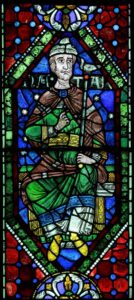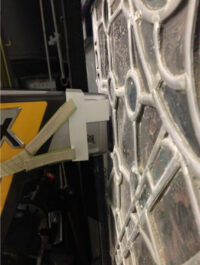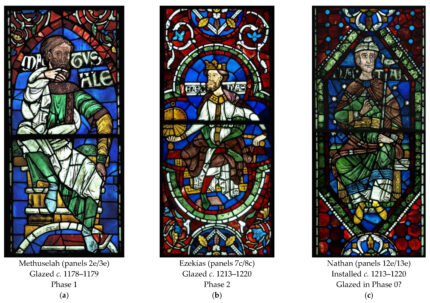 A new study has discovered that some of the stained glass in Canterbury Cathedral predates the 1170 murder of Thomas Becket by as much as four decades, which would make them among the oldest known stained glass windows in England and the world.
A new study has discovered that some of the stained glass in Canterbury Cathedral predates the 1170 murder of Thomas Becket by as much as four decades, which would make them among the oldest known stained glass windows in England and the world.
While there are fragments of painted window glass going back to late antiquity, the large figurative windows made by joining pieces of colored glass with soldered lead cames that we think of by “stained glass” took off with the development of Gothic architecture that allowed the installation of great windows. Very few examples predate the late 12th century.
Before this recent study, the oldest stained glass windows in the cathedral were believed to have been made after the fire that devastated the building in 1174. A series depicting the ancestors of Christ were installed in the clerestory windows of the choir between 1175 and 1220 during the post-conflagration rebuilding program (with a couple of decades of delays thrown in there when arguments between the archbishop and monks of Canterbury put a hold on glazing). They were reconfigured and moved to the Great South Window in the 1790.
In 1987, art historian Madeline Caviness proposed that four of the figures in the Ancestor Series were not Gothic but rather Romanesque in style, that they may have been older works adapted and reused in the late 12th, early 13th century. At the time, it was not possible to confirm or deny this hypothesis via scientific analysis of the elements in the glass because samples would have had to be taken, and of course one is not allowed to chip off chunks of Canterbury Cathedral’s 800-year-old (at least) windows.
 University of College London (UCL) researchers were recently able to test Caviness’ hypothesis using a non-invasive technology modified specifically for use on stained glass windows still in their original architectural context. They customized a portable x-ray fluorescence (pXRF) spectrometer with an ingenious attachment dubbed the WindoLyzer that counters interference from the lead cames that bind the glass pieces. The attachment was modeled with software and 3D printed, so it can be replicated at will at little expense for easy and cheap in situ element analysis.
University of College London (UCL) researchers were recently able to test Caviness’ hypothesis using a non-invasive technology modified specifically for use on stained glass windows still in their original architectural context. They customized a portable x-ray fluorescence (pXRF) spectrometer with an ingenious attachment dubbed the WindoLyzer that counters interference from the lead cames that bind the glass pieces. The attachment was modeled with software and 3D printed, so it can be replicated at will at little expense for easy and cheap in situ element analysis.
Researchers looked at three figures that were part of Ancestors of Christ series: Methuselah, Ezekias and Nathan. Nathan is one of the figures Caviness pointed to as being Romanesque. The pXRF shines an x-ray beam on the glass. The glass radiates and the spectrometer can detect the chemical element composition of the glass from that radiation.
The condition of the surface of the cathedral glass, already prone to deterioration from its relatively unstable composition and then exposed for centuries to nefarious environmental elements, made it challenging to characterize all of the elements in glass. Five of them are fully quantifiable by pXRF — Copper (Cu), Zinc (Zn), Rubidium (Rb), Strontium (Sr) and Zirconium (Zr) — and together they are sufficient to date and identify glass recipes by region, sometimes even by workshop.
Methuselah and Ezekias were made of similar glass and installed in the arched clerestory windows during the reconstruction, ca. 1178-9 for Methuselah, ca. 1213-1220 for Ezekias. Nathan was installed in the clerestory around the same time as Ezekias, but the type of glass marks it as a much earlier production, made between 1130 and 1160.
Now that Nathan has been confirmed to predate the fire by decades, researchers think the windows that managed to survive the conflagration were dismantled, stored and then reinstalled as part of the Ancestor Series.
Prof Caviness said she was “delighted” to hear that her assessment had been confirmed by Dr [Laura] Ware Adlington.
“The scientific findings, the observations and the chronology of the cathedral itself all fit together very nicely now,” she told BBC News. Prof Caviness, who is now 83, told me that the finding had jolted her out of a “Covid numbness” that she had been feeling.
“I wish I was younger and could throw myself more into helping Laura with her future work. But I’ve certainly got a few more projects to feed her.”
The study has been published in the journal Heritage and can be read here.
